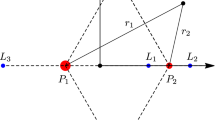Abstract
In this article we treat the 'Extended Sitnikov Problem' where three bodies of equal masses stay always in the Sitnikov configuration. One of the bodies is confined to a motion perpendicular to the instantaneous plane of motion of the two other bodies (called the primaries), which are always equally far away from the barycenter of the system (and from the third body). In contrary to the Sitnikov Problem with one mass less body the primaries are not moving on Keplerian orbits. After a qualitative analysis of possible motions in the 'Extended Sitnikov Problem' we explore the structure of phase space with the aid of properly chosen surfaces of section. It turns out that for very small energies H the motion is possible only in small region of phase space and only thin layers of chaos appear in this region of mostly regular motion. We have chosen the plane (\(r,\dot r\)) as surface of section, where r is the distance between the primaries; we plot the respective points when the three bodies are 'aligned'. The fixed point which corresponds to the 1 : 2 resonant orbit between the primaries' period and the period of motion of the third mass is in the middle of the region of motion. For low energies this fixed point is stable, then for an increased value of the energy splits into an unstable and two stable fixed points. The unstable fixed point splits again for larger energies into a stable and two unstable ones. For energies close toH = 0 the stable center splits one more time into an unstable and two stable ones. With increasing energy more and more of the phase space is filled with chaotic orbits with very long intermediate time intervals in between two crossings of the surface of section. We also checked the rotation numbers for some specific orbits.
Similar content being viewed by others
References
Alekseev, V.M.: 1968a, 1968b, 1969a, Quasirandom dynamical systems I, II, III, Math. USSR Sbornik 5, 73–128; 6, 505-560; 7, 1-43.
Alekseev, V. M.: 1969b, Mat. Zametki 6(4), 489–498.
Alfaro, J. M. and Chiralt, C.: 1993, Invariant rotational curves in Sitnikov's problem, Celestial Mechanics and Dynamical Astronomy 55, 351.
Arnold, V. I.: 1988, Dynamical Systems III, Springer, Berlin.
Contopoulos, G.: 1971, Astron. J. 76, 147.
Contopoulos, G., Voglis, N., Froeschlé, Cl, Gonczi, R., Lega, E., Dvorak, R., Lohinger, E.: (submitted to Celestial Mechanics and Dynamical Astronomy).
Dvorak,R.: 1993, New numerical results to the Sitnikov problem, Celestial Mechanics and Dynamical Astronomy 56, 71.
Euler, L.: 1764, De motu corporis ad duo centra virium fixa attracti, Nov. Comm. Petrop. 10, 207 and 11, 152.
Hagel, J.: 1992, A new analytic approach to the Sitnikov problem, Celestial Mechanics and Dynamical Astronomy 56, 267.
Hagel, J. and Trenkler, T.: 1992, A computer aided analysis of the Sitnikov problem, Celestial Mechanics and Dynamical Astronomy 56, 81.
Guckenheimer, J, Holmes, P.: 1983, Nonlinear Oscillations, Dynamical Systems, and Bifurcations of Vector Fields, Springer.
Liu, J., Sun, Y. S.: 1991, On the Sitnikov Problem, Celestial Mechanics and Dynamical Astronomy 49, 285.
Mac Millan, W. D.: 1913, An integrable case in the restricted problem of three bodies, Astronomical Journal 27, 11.
Marchal, C.: 1997, Survey paper: Qualitative Methods and Results in Celestial Mechanics, ONERA T.P., Nr. 1975–77.
Marchal, C.: 1990, The Three-body Problem, Elsevier.
Moser, J.: 1973, Random and Stable Motion in Dynamical Systems, Princeton University Press.
Pavanini, G.: 1907, Sopra una nuova categoria di soluzioni periodiche nel problema dei tre corpi, Annali di Mathematica, Serie III, Tomo XIII.
Sitnikov, K.: 1960, Existence of oscillatory motions for the three-body problem, Dokl. Akad. Nauk, USSR, 133(2), 303.
Wodnar, K.: 1991, New formulations of the Sitnikov problem, in A. E. Roy (ed), Predictability, Stability and Chaos in N-Body Dynamical Systems, Plenum Press, New York.
Wodnar, K.: 1992, The original Sitnikov article-New insights, master's thesis, University of Vienna.
Wodnar, K.: 1993, The original Sitnikov article-New insights, ext. in R. Dvorak and J. Henrard (eds), abs., Qualitative and Quantitative Behaviour of Planetary Systems, Kluwer Academic Publishers, Dordrecht.
Wodnar, K.: 1995, Analytical approximations for Sitnikov's problem, in A. E. Roy and B. A. Steves (eds.), From Newton to Chaos. Modern Techniques for Understanding and Coping with Chaos in N-body Dynamical Systems, NATO, ASI, Series B, Vol. 336, Plenum Press, New York, 513.
Author information
Authors and Affiliations
Rights and permissions
About this article
Cite this article
DVORAK, R., SUI SUN, Y. THE PHASE SPACE STRUCTURE OF THE EXTENDED SITNIKOV-PROBLEM. Celestial Mechanics and Dynamical Astronomy 67, 87–106 (1997). https://doi.org/10.1023/A:1008265310911
Issue Date:
DOI: https://doi.org/10.1023/A:1008265310911



